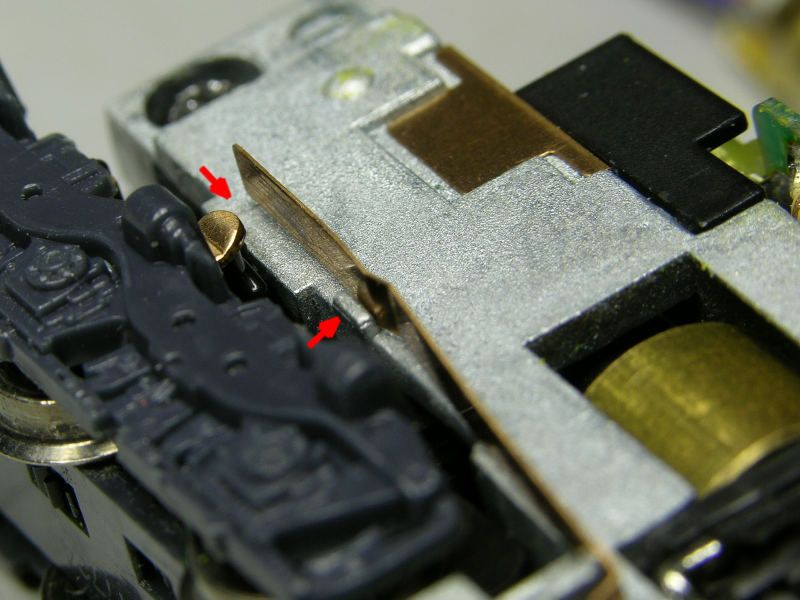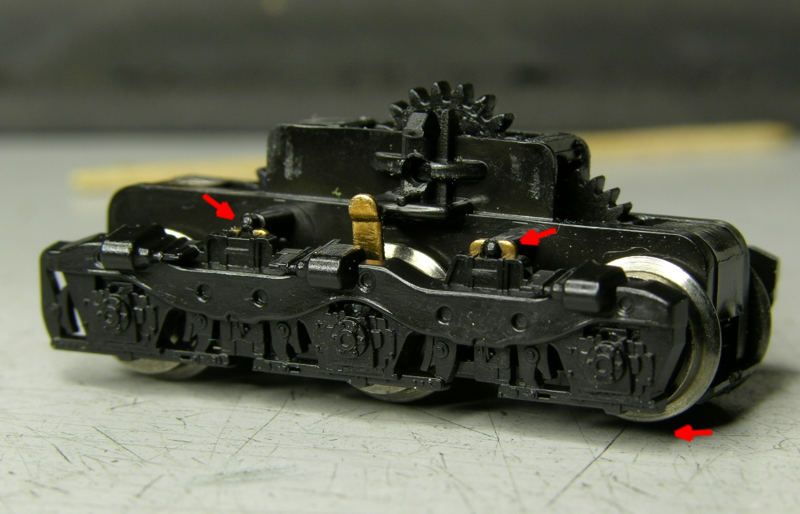I received Dick's ailing locos today. Like a kid with presents at Christmas, I could not resist them. Mmmmm... fresh
meat models to be taken apart! I put all my other projects aside so I can evaluate these puppies! I can clearly see why these are very poor pullers. Read on.
Initial findings: Loco #1 (road # 7421)1 gray truck (rear), 1 black truck (front). Lots of vertical play in both trucks - might be normal for this model...
Electric pickup ok on both trucks and all wheels, but a bit intermittent. Suspect dirty contact strips between truck and chassis.
Front truck (black) is missing its idler gears! That makes it a dummy (freewheeling) truck. Locomotive is only propelled by the rear truck!
Front coupler - Accumate. Affixed with a screw and some hot-melt glue. The glue got in the coupler pocket and prevents the coupler from swinging freely.
Rear coupler - MT. It is affixed using the Atlas stock plastic retainer and some hot-melt glue. It is very loosely mounted - has lots of vertical play.
Findings after disassembly:Motor and the rest of the chassis drive train is assembled correctly.
The electric pickup strips for the trucks are bent down unevenly, which could cause poor electrical pickup.
Initial findings: Loco #2 (road # 7413)1 gray truck (front), 1 black truck (rear). Front truck has lot of vertical play. Rear truck seems not to have as much vertical play.
Front left power pickup strip is pinched under a tab in the chassis (not contacting the metal nub on the truck's sideframe).

Rear right pickup strip is pushed towards the outside of the locomotive (not riding over the nub on the truck's sideframe metal nub). This causes poor electrical pickup.

Front truck still has its idler gears but it is freewheeling (again, a dummy truck). I suspect that the worm gear has been removed. This locomotive is also only propelled by its rear truck!
Front coupler - MT, mounted with a screw. Works correctly.
Rear coupler - Accumate, mounted with a screw. Works correctly.
Findings after disassembly:The freewheeling of the truck was caused by incorrectly installed worm/spur gear. It is flipped 180 degrees, so the spur gear part of the worm gear does not mesh with the idler gears.

It appears that in these models the worm bearing blocks are not square. On this particular model, both inside bearing blocks were installed 90 degrees off from their correct position. Because of that, they were press-fit into the guides in the chassis. But they were not fully seated, causing the worm to be skewed, not parallel to the model's center line.

The power pickup strips for the trucks are bent down unevenly which could cause poor electrical pickup.
EDIT/Update:The freewheeling truck on this model is also not assembled correctly. The sideframe bearing/pickup plate on one side is not seated properly causing the entire truck to be twisted slightly. That distortion caused the wheelsets to bind. That creates extra drag, slowing the model down.

As far as the vertical play in trucks, this seems to be due to the worn out surfaces in the gear tower: A pivot point which in which the chassis rests and the sloped truck retainers on top of the gear tower.
The U-joints on both models are fine.
These models can be brought back to perfect operating condition. I'll just need to get some parts (gear towers and some idler gears. Stay tuned for updates...